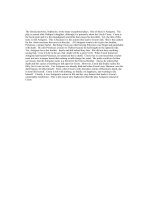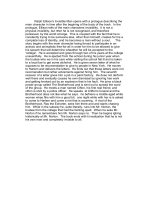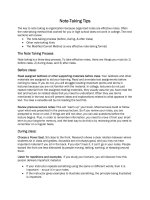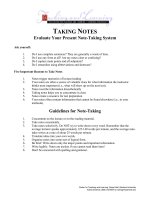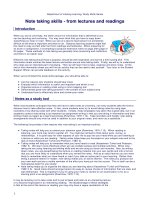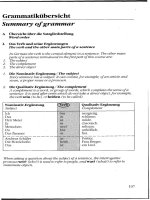Summary of doctoral dissertation Effect of initial physical properties of roller compacted concrete to construction schedule of concrete gravity dam in Vietnam
Bạn đang xem bản rút gọn của tài liệu. Xem và tải ngay bản đầy đủ của tài liệu tại đây (842.21 KB, 27 trang )
MINISTRY OF EDUCATION
MINISTRY OF AGRICULTURE
AND TRAINING
AND RURAL DEVELOPMENT
THUY LOI UNIVERISITY
LE QUOC TOAN
EFFECT OF INITIAL PHYSICAL PROPERTIES OF ROLLER
COMPACTED CONCRETE TO CONSTRUCTION SCHEDULE OF
CONCRETE GRAVITY DAM IN VIETNAM
Major:
Hydraulic engineering
Code No:
62.58.40.01
SUMMARY OF DOCTORAL DISSERTATION
HANOI, 2016
This scientific work has been accomplished at: Water Resources University
Supervisor 1: Prof.Dr. Vu Thanh Te
Supervisor 2: Assoc.Prof.Dr. Do Van Luong
Reviewer 1: Assoc.Prof.Dr. Nguyen Thanh Sang
Reviewer 2: Assoc.Prof.Dr. Vu Huu Hai
Reviewer 3: Assoc.Prof.Dr. Hoang Pho Uyen
This doctor dissertation will be defended at university graduate council of Thuy
Loi Univeristy
At
h00, date
month
year 2016
It is possible to find out information about this document at:
- National Library of Vietnam
- Library of Thuy Loi University, Hanoi
INTRODUCTION
1. Reasons for choosing the research
The outstandingly advantages of Roller Compacted Concrete (RCC) are faster
speed of construction, lower price. At present, its applications have been quite
common in Vietnam. Almost the principal calculations in design and
construction of RCC Dam inherited from basic concepts of normal concrete or
taking from foreign documents. Recently, there have been some incidents
happened at main dam of RCC dams, but no evaluations or deeply summaries
addressed.
Even though the scientific evident and theoretical calculations in applications of
RCC technology used in Vietnam, but there is lack of in-depth research. The
studies about construction schedule of RCC dams are vital in order to make
projects become more reasonable and effective.
2. The Purpose of Research
This study focus on the behaviour and quantify initial physical properties of
RCC, from the beginning of hydration to designated characteristic of RCC, in
order to define the thermal evolution, thermal stresses. By doing this, the
appropriate speed of construction can be established when building RCC dam
project.
3. Research Objectives
RCC dams are constructed and under construction in Vietnam.
4. Research scope
This research aims at the effect of initial physical propertieson construction
schedule of RCC dams, from the beginning of hydration to designated
characteristic of RCC.
5. Methodology of Research
This study uses the research methods according to present design codes.
6. Significance of Research
- Clarify behavior, quantify and determine the impact of initial physical
properties of RCC on the thermal evolution, thermal stress and construction
schedule. Propose methods for determining reasonable construction schedule in
the conditions of Vietnam
- RCC technology has been applied on more than 20 concrete gravity dam in
Vietnam. However, the quality of these buildings have not considered properly
1
and researched in systematical way. Therefore, results of this study aim to
determine the method, providing reliable calculation tools for the design and
construction of RCC. It is also suggested solutions to monitor, repair and ensure
the safety for constructed buildings and under construction projects.
7. New aspects of Research
This study has gained new points as follow:
Find out information about relationships of two RCC aggregate gradation such
as compressive strength development over time, tensile strength development
over time, shrinkage strain over time, Elastic Modulus of Concrete over time.
Completing and supplementing thermal evolution calculation and thermal
stresses in ANSYS software in order to using as a tool for inspecting the
construction speed of Dong Nai 4 dam.
8. Structure of Dissertation
This dissertation includes introduction, four chapters, conclusion and
discussions. 49 references, 04 authority publications. The main content of the
document presented in 144 pages, with 69 tables, 116 figures and 06
appendices.
CHAPTER 1: OVERVIEW OF ROLLER-COMPACTED CONCRETE
AND RESEARCH QUESTIONS AND OBJECTIVES
1.1. History and development of roller compacted concrete in the world
1961, it was first used at Alpe Gera dam - Italia, Manicongan dam – Canada and
Thach Mon - Taiwan;
1970 there is research about RCC in America; 1980 Willow Creek dam was
built at Oregon state with a height of 52 m, and a length of 543 m, constructed
of roller-compacted concrete;
1970 England, Dunstan, the Construction Industry Research and Information
Association (CIRIA) carried out studies for high fly ash content RCC, testing at
Water Treatment Plant Tamara – Coruwall (1976) & Wimbledall (1979);
1974, Japan began research about RCC and Shimajigawa dam, 89 m high and
240m length, was the first Japanese RCC dam with 165,000m3 placed RCC in
total of 317,000m3 concrete for this dam . 1980, China researched and applied
RCC technology; so far China is now the leading country of the world in the
construction RCC dams;
2
1.2. Construction of RCC dam in Vietnam
From 1996 to 2006, the number of RCC dams with higher cemetious content
increased from 43.3% in 1996 to 47.4% in 2002 and 53.4% in 2006. Since
December 2005, total 285 RCC dams have been constructed.
1.3. Researches of Roller-Compacted Concrete in Vietnam
Vietnam has been researched about RCC dams since 1990. In 2003, Pleikrong
hydraulic dams is the first RCC buildings in Vietnam. Until now, there were
more than 20 gravity concrete dams completed or being under construction by
using RCC technology.
1.4. Literature review of RCC research in Vietnam and the world
1.4.1. Literature review of RCC research in the world
1.4.1.1. Findings of roller compacted concrete in France
From 1988 to 1996, France has implemented research projects nationally Bacara
of RCC dam [4].
1.4.1.2. Findings of roller compacted concrete in US
The American Concrete Institute: provide high speed of construction and cost
savings, but seepage and cracks easier occur easily
1.4.1.3. Findings of roller compacted concrete in Japan
RCC has quality of waterproofing and strength as CVC
1.4.1.4. Findings of roller compacted concrete in China
The method of RCCD in China based on the experience and lessons of two
approaches RCD and RCC combined with fly ash additives available in
domestic market.
1.4.2. Research on RCC in Vietnam
Research about using domestic material to design aggregate gradation:
documents [9]; [10]; [11].
Research about using mineral admixture: documents [12], [13], [14], [15], [16],
[17], [18], [19].
Research about applying waterproofing material for RCC: documents [20], [21];
Research about thermal in RCC: documents [22], [23], [24], [25];
3
Research about construction technologies for RCC: documents [26], [27], [28],
[29].
1.5. The remaining issues of RCC research, objective of dissertation
1.5.1. The remaining issues of RCC research
- Improving the quality combined with surface layer to satisfy dam height
- The quality of combined surface layer is a cause of seepage
- The RCC construction schedule: it depends on thermal evolution, thermal
stress, which ensure anti cracking ability of dam. These factors directly
influenced by the initial physical parameters of RCC. Therefore, research is
necessary to determine a reasonable construction schedule while building RCC
dams.
1.5.2. Research orientation content of this research
To select materials for RCC aggregate gradation, provide experimental method
to figure out physical properties of RCC by current codes.
To carry out experiments to manufacture 02 RCC aggregate gradation, which
commonly use in Middle and South of Tay Nguyen, namely pozzolanic active
mineral RCC and fly ash active mineral RCC.
Design of experiments to figure out the development of RCC initial physical
properties of 2 optimum aggregate RCC over designated time by using nonlinear functions.
Integrate ANSYS to calculate the heat & thermal stress in RCC dams.
Using integrated ANSYS to find out the appropriate construction speed based
on temperature control and thermal stresses in RCC dam.
Research Process Flowchart shown in Figure 1.1
Figure 1. 1. Research process of Construction Schedule of RCC
4
CHAPTER 2 SCIENTIFIC BASIS AND EXPERIMENTAL METHODS
TO DETERMINE AGGREATE GRADATION & PHYSICAL
PARAMETORS RCC
2.1. Factors affecting the physical parameter of RCC
The characteristic of materials manufactured RCC
Ingredients of aggregate gradation RCC
Construction Environment of RCC
Construction process of RCC
2.2. Choice materials used in the research and manufacture of aggregate
gradation RCC
Testing materials are ensured about the number and the stability quality. It is
also has been used in RCC building, near the construction site, the quality of
materials to satisfy technical requirements for RCC.
2.2.1. Materials used for grading RCC-P (pozzolanic additives)
- Concrete: concrete PCB40 Fico, TCVN 6260: 2009 [30]
- Pozzolan: mine number 4A Dak Nong, TCVN 8825: 2011 “Mineral
admixtures for RCC” [31]
- Water: TCVN 4506: 2012 "Water for mixing concrete and mortar - Technical
specification” [32]
- Small aggregate: in Dak Nong, TCVN 7570: 2006 and ASTM C29: 2003.
- Crushed stone: in Dak Nong, TCVN7570:2006“Aggregates for concrete and
mortar - Specifications”.
- Plasticizers and set-controlling admixtures: Plastiment 96, ASTM C494 type
D.
2.2.2. Materials used for grading RCC-T (RCC using fly ash additives)
- Concrete: concrete PC40 Ha Tien 1, TCVN 2682: 2009 [34]
- Fly ash: Formosa, TCVN 8825: 2011 “Mineral admixtures for RCC”.
- Water: TCVN 4506: 2012 "Water for mixing concrete and mortar - Technical
specification”.
- Sand: in Ninh Thuan, TCVN7570:2006“Aggregates for concrete and mortar Specifications”.
5
- Crushed stone: in Ninh Thuan, TCVN7570:2006“Aggregates for concrete and
mortar - Specifications”.
- Fine admixtures: Non-active fillers, about 15% of the volume of sand.
- Plasticizers and set-controlling admixtures: Plastiment 96, ASTM C494 type
D.
2.3. Determine the optimum gradation RCC
2.3.1. Method to determine the optimum gradation RCC
This study use the method to design gradation ACI 211.3R-2002 [5], using
experiments and theory "Experimental planning" to figure out the optimum
gradation RCC, especially in strength and using materials.
2.3.2. Experimental planning theory in determine gradation RCC [35]
2.4. Methods to determine physical properties of RCC
The experimental procedure show in Figure below:
Material
of
RCC
Aggregate
gradation
Mixing,
,
making Test
Test
Specimens
Curing
Test
Specimen
Experim
ental
apparatus
Experim
ental
Results
Formula
Summary
Define
Propert
ies
Figure 2.3. Experimental procedure determine the physical properties RCC
(There are 6 physical factors found in this procedures through headings 2.4.1 to
2.4.6, namely standard, sample and experimental apparatus; formula to
determine these properties).
2.5. Determine optimum aggregate gradation RCC
2.5.1. Planning manipulate experimentally determined gradation
2.5.2. Determine optimal aggregate gradation RCC-P
Ratio: mineral admixture/ adhesives = 0.63, 0.65 and 0.67; water/ adhesives =
0.56; 0.58 and 0.60; adhesives = 190 kg/m3; Sucking sand level Sand/(sand+
crushed stone) = 0.37; mineral admixtures = 1.8 liter/100kg adhesives
6
Table 2. 1. Table encryption empirical coefficient
Real variable
PGK/CKD
N/CKD
Variable code
X1
X2
-1
0,55
0,56
0
0,6
0,58
Δ
0,05
0,02
1
0,65
0,6
Table 2. 2. The composition of aggregate RCC - P empirical
C1
C2
Real
variable
MA/A
G1
-1
-1
0,55
0,56
85
106
1414
830
106
15
G2
1
-1
0,65
0,56
66
125
1417
832
106
13
G3
-1
1
0,55
0,60
85
106
1401
823
114
9
G4
1
1
0,65
0,60
66
125
1404
825
114
5
G5
-1,412
0
0,529
0,58
88
102
1407
826
110
16
G6
1,412
0
0,671
0,58
62
128
1411
829
110
8
G7
0
-1,412
0,60
0,552
75
115
1418
833
105
17
G8
0
1,412
0,60
0,608
75
115
1400
822
116
6
G9
0
0
0,60
0,58
75
115
1409
828
110
8
G10
0
0
0,60
0,58
75
115
1409
828
110
11
G11
0
0
0,60
0,58
75
115
1409
828
110
10
G12
0
0
0,60
0,58
75
115
1409
828
110
9
G13
0
0
0,60
0,58
75
115
1409
828
110
10
Case
Variable code
Consumption materials for 1 m3 (Kg)
W/A
C
MA
S
S
W
Vc
(s)
The samples according to the gradation on the result compressive strength Rn
(MPa) at the age of 90 days and 365 days of age as follows:
Table 2. 3. Results compressive strength RCC - P
G
G1
G2
G3
G4
G5
G6
G7
G8
G9
G10
G11
G12
G13
Rn90
Rn365
14,8
15,4
13,8
15,11
14,2
15,1
14
15,0
14,5
15,4
13,5
15,0
15,2
15,5
14,6
15,2
14
15,2
14,3
15,1
14,5
15,3
14,3
15,4
14,8
15,3
The regression equation for compressive strength of 365 days (2.1):
Rn365 =+15,26 - 0,12X1 – 0,10X2 + 0,047X1X2 – 0,061X12 + 0,014X22
The rate of mineral admixture/adhesives and rate of water/adhesives saw
influences to strength of RCC, by following results:
7
Figure 2.12. The correlation of
MA/adhesion and ratio Water/adhesion
of Rn365 RCC-P
Figure 2.13. The correlation contour
plots of MA/adhesion and ratio
Water/adhesion of Rn365 RCC-P
The optimum aggregate gradation RCC-P: Cement: 75kg, mineral admixtures:
115Kg, sand 804kg, crushed stone 4, 75÷19 (mm): 722kg crushed stone 20÷50
(mm): 670kg, water 110 liter, chemical admixture 3.4 liter.
2.5.3. Determine optimal aggregate gradation RCC-T
Ratio of admixture/ adhesives: 0.58; 0.6 and 0.62; water/ adhesives:0.56,0.58
and 0.6.Adhesives=200kg. Admixtures:15% weight of sand; Sucking sand level
Sand/(sand+crushed stone)=0.34; chemical admixture=1.0 liter/100kg/adhesive.
The regression equation for compressive strength of 365 days (2.2):
Rn90 = - 785,34+1291,5X1+1471,34X2+ 231,25X1X2 - 1204,06X12 1391,56X22
Figure 2. 16. The correlation of
MA/adhesion ratio and Water/adhesion
ratio of Rn90 RCC-T
Figure 2. 17. The correlation contour
plots of MA/adhesion ratio and
Water/adhesion ratio of Rn90 RCC-T
Optimum gradation of RCC-T: Concrete: 80kg, Mineral Admixture: 120Kg,
sand 687 kg; crushed stone: 5÷19 (mm): 479kg, 20÷39 (mm): 295kg, 40÷60
(mm): 628kg, water 115 liter, Chemical Admixture 2 liters.
8
CHAPTER 3 RESEARCH THE DEVELOPMENT OF SOME INITIAL
PHYSICAL PARAMETER OF ROLLER COMPACTED CONCRETE
3.1. Research the development of some initial physical parameter of roller
compacted concrete
3.1.1. Research the development of compressive strength of RCC (Rn)
The correlation function show the development of Rn for gradation RCC-P: Yn1
= 2.64ln(x) + 2.24 with R2= 0.9 (3.1a); gradation of RCC-T: Yn2 = 4.54ln(x) +
2.52 với R2= 0.93 (3.1b)
Table 3. 3. Compressive strength of RCC-P by calculations
Time (date)
Compressive strength (Mpa)
% discrepancy with the previous day
1
3
5
7
14
28
56
90
2.24 5.14 6.49 7.38 9.21 10.4 12.87 14.12
26.30 9.99 5.84 10.68 19.87 16.58 9.73
Table 3. 4. Compressive strength of RCC-T by calculations
Time (date)
1
3
5
7
14
28
56
90
Compressive strength (Mpa)
2.52 7.51 9.83 11.35 14.5 17.65 20.8 22.95
% discrepancy with the previous day
32.48 11.49 6.57 11.77 21.70 17.83 10.36
Figure 3.3. Compressive strength ~ time for 2 gradation RCC-P& RCC-T
3.1.2. Research the development of tensile strength of RCC (RK)
The correlation function show the development of Rk for gradation RCC-P:
Yk1 = 0.258ln(x) + 0.029 with R2 = 0.9764 (3.2a) for gradation RCC-T:
Yk2 = 0.289ln(x) + 0.051 with R2= 0.971(3.2b).
9
Table 3.7. Compressive strength of two gradation RCC-P&RCC-T according
two correlation and regression
Age (days)
Rk (Mpa)
RCCP
(%) increase
Rk (Mpa)
RCCT
(%) increase
1
0.02
0.05
3
0.28
50.33
0.37
46.63
5
0.39
14.89
0.52
14.28
7
0.47
8.10
0.61
7.83
14
0.63
2.76
0.81
2.70
28
0.89
1.06
1.01
1.04
56
1.07
0.43
1.21
0.43
90
1.19
0.24
1.35
0.24
Figure 3.6. Correlation of Rk by ages of RCC-P&RCC-T
Table 3.8. Compare the increasing speed of tensile strength, compressive
strength of RCC
Increasing rate
Increasing
Gradation Rn28 Rn90
Rk28
Rk90
(%)
rate (%)
RCC-P
11.8 15.2
129
0.91
1.28
140
RCC-T
18.8 20.8
111
1.09
1.31
120
3.1.3. Study of Shrinkage strain of RCC
3.1.3.1. Study of thermal shrinkage strain of RCC
Figure 3.7. The development of thermal at some points of RCC sample
10
3.1.3.2. Study of thermal coefficient of RCC
Table 3.12. Some thermal coefficient of RCC
Original of
Aggregate
River sand, gravel
Artificial sand,
Crushed stone,
limestone
Water/(Cement
Mineral Additives)
0.44
Water
(Kg/m3)
70
Coef. BDN 10-6/0C
0.86
93
5.803
9.064
3.1.3.3. Research shrinkage due to dehydration (dry shrinkage) of RCC
Table 3.13. Volumetric shrinkage of RCC
Coefficient of Volumetric shrinkage Cn (%*10-2)
Age
RCCP
RCCT
1
2
3
4
5
6
7
14
28
56
90
365
0.30
0.61
1.11
1.51
1.91
2.11
2.48
2.79
3.44
3.95
4.02
4.23
0.42
0.61
0.90
1.11
1.61
1.80
2.02
2.21
2.51
2.65
2.78
-
Figure 3.10. The relationship of shrinkage~time for two gradation: RCCP&RCC-T
Correlation and regression of shrinkage with time of gradation RCC-P:
Ycn1 = 0.0075ln(x) + 0.0057 with R2= 0.9216
(3.3a); gradation BTĐL-T:
2
Ycn2 = 0.0057ln(x) + 0.005 with R = 0.9116 (3.3b)
3.1.4. Heat transfer coefficient, Coefficient of thermal conductivity
3.1.4.1. Heat transfer coefficient
Heat transfer coefficient (HSTN) shows the diffusion of heat from concrete (unit
m2/h and was marked as a). The bigger value of HSTN, the less time require to
11
temperature at points of concrete sample reach same values. HSTN of concrete
depends on type of aggregate, the amount of aggregate, amount of water and
weight of concrete. Generally, HSTN has the reverser trend when temperature
increase, but it has the same pattern with proportion of aggregate in concrete.
The reason for this is that RCC used less water and more aggregate than CVC so
that HSTN of RCC larger than CVC, but the different are not so significant [41].
3.1.4.2. Coefficient of thermal conductivity
= . C. γ; with is Coefficient of thermal conductivity of concrete [KJ/(m.h
.0C)]; : HSTN(m2/h); C: heat capacity of concrete [KJ/(Kg.0C)]; γ: Weight of
concrete [Kg /(m3)]
Table 3.14. Research results on the thermal characteristics of RCC
Amount
of
120
150
160
210
236
adhesive
3
(kg/m )
t (0C)
40
60
40
60
40
60
40
60
40
60
( m2/h) 0.0039 0.0038 0.0039 0.0038 0.0034 0.0033 0.0046 0.0049 0.0039 0.0038
8.25
8.46
8.25
8.46
7.2
7.91
7.0
8.21
8.46
[kJ/(m.h
.0C)]
C [kJ/(kg
0.87
0.91
0.84
0.9
0.84
0.9
0.96
0.87
0.91
.0C)]
-6
0
a (10 / C) 9.06
9.06
9.25
9.25
8.35
8.35
10.4
10.4
9.06
9.06
3.1.5. Research Elastic modulus of RCC
3.1.5.1. Static Elastic modulus (EM) in compression
Figure 3. 13. Evolutions of EM of RCC-P & RCC-T
12
The correlation functions saw EM of gradation RCC-P: Yđh1 = 0.4823ln(x) +
0.0946 with R2= 0.9758 (3.5a); gradation RCC-T: Yđh2 = 0.5031ln(x) + 0.0808
with R2 = 0.9831 (3.5b)
EM of two gradation RCC-P & RCC-T shows no significant in the total amount
of aggregate. However, the EM of RCC-T is higher than RCC-P due to the
higher amount of adhesion of RCC-T in comparison to RCC-P.
3.1.5.2. Static Elastic modulus in tensile of RCC
Static Elastic modulus in tensile of RCC influenced by many factors, which
have similar rule. By [38], Elastic modulus in tensile of RCC at the age of 90
days (with RCC of 3 level gradation) = 1.3 ÷ 1.48 Elastic modulus in
compression. Particularly, CVC has similar of Elastic modulus in tensile and
compression.
3.1.5.3. Ultimate tensile strain of RCC
It is the biggest value of Rk when the sample split of and using maximum value
to present. It influenced by the amount of adhesion, Rk, Elastic modulus in
tensile, age of concrete etc. (mainly on adhesion and Rk; when fixed Rk, then it
depends on adhesion)
Ultimate tensile strain of concrete conducted from laboratory experiment saw
massive bigger value than Ultimate tensile strain. This is due to using wet sieve
to remove coal aggregate, which has diameter larger than 40 mm, then the rate
of mortar in laboratory sample than in dam.
3.1.6. Study of maximum increase of temperature in RCC
0
Maximum temperature T of RCC can be measured by the increase of T0 in state
of RCC, in which it did not dissipate heat and did not absorb external energy. In
0
0
construction, T of dam < the maximum T . This is due to the absorption or
release energy into environment. Regarding the released heat by hydration
0
process in RCC, if the absorbs heat lower the built up heat, T will increase over
0
time, until the speed radiating heat transmission rate, then T start decreasing to
0
stability of T .
Table 3.16. Hydration heat of RCC used mineral additives (MA)
Type of
cement
MA
Pozzolan Ba Ria
PC40
Ha Tien 1
Fly-ash Fomosa
Proportion of
mineral
admixture (%)
0
40
60
0
40
60
13
Heat of Hydration by age (J/g)
3 day
5 day
7 day
230.1
138.4
100.5
234.5
140.6
101.5
263.7
175.6
137.2
269.3
180.2
142.3
321.2
214.6
161.3
342.4
219.6
166.2
Table 3.17. Time to reach maximum temperature according to the amount of
mineral additives
Type of
cement
PC40
Ha Tien 1
Proportion of mineral
additives (%)
0
40
60
Record time when appear rising
temperature (hours)
18
38
72
3.2. Construction technology and changes in temperature, crack due to heat
in RCC dam
3.2.1. Construction technology of RCC dam [5]
Diagram of RCC’s technical construction shown in Figure. 3.1.
Mixing
Compact
rolling
Transportation
Curing dam’s
surface
Leveling
Compacting
Make rough
Cast Sand
mortar
Cut horizontal slots
Setup horizontal
slots
Figure 3. 1. Construction phrases of RCC
3.2.2. Thermal evolution, crack due to heat in RCC dam [45], [44] [41] [38]
The process of temperature changes of RCC saw in Figure 3.2.
Figure 3. 2. The process of temperature changes in concrete block
3.3. Factors affecting construction schedule of RCC dam
Construction schedule of RCC, called as the dam’s construction speed, is an
important factor to determine plans for the building. Construction speed is
detailed by some parameter such as the number of layer in one casting phrases,
layer thickness, the resting time between each phrases. Furthermore, there are
other factors related to construction like transportation, determine the casting
14
areas, making construction slots etc., and intensity of construction, construction
speed of the dam related to loading problems, as well as heat accumulation in
the RCC dam’s body.
The speed of RCC based on principal of temperature control, thermal stress. It
depends mainly on RCC’s gradation, initial temperature of RCC mixture and
environmental temperature at the constructing time of RCC dam.
The findings of study about the initial physical parameter of RCC
conducted that:
- Rn of RCC at the age < 28 day achieved low values, especially at 10-day age.
This affected to the construction process if the building require fast execution.
For example, the machine loadings can make lower development of RCC
graded.
- The development speed of Rk is initially slow and the rate of increase is lower
than Rn. Rk is a substantial parameter of construction. This due to the fact that if
Rk of RCC reach low value, the tensile stress get higher value, caused by loads
in construction process, temperature etc., leading to cracks of concrete.
- Young Modulus of RCC goes in line with normal concrete, and it focus on the
first 7 days after mixing and concreting.
- Young Modulus of RCC is higher than of CVC. It mainly depends on the
ingredients and aggregate gradation. This parameter increase crack resistance of
RCC.
- Based on the correlation function of physical properties, which conducted by
experiments of two gradation RCC, the relationships of Rn over time (Rn~ t); Rk
over time (Rk~ t); Coefficient of shrinkage over time (ε ~ t) and Young Modulus
(E ~ t) etc. These results can be used to controlled thermal evolution and
calculated thermal stresses.
CHAPTER 4 USING ANSYS SOFTWARE AND THE RESULT OF
INITIAL PHYSICAL PROPERTIES OF RCC RESEARCH INSPECT
THE CONSTRUCTION SCHEDULE OF DONG NAI 4 DAM
4.1. ANSYS software and ability to compute heat and thermal stress
4.1.1. Ability to compute heat, thermal stress of ANSYS [46].
ANSYS is a simulation analysis software based on finite element method to
carry research of structural, thermal, fluid, electromagnetic, sound etc. The
15
current version is ANSYS 16. ANSYS has many modulus with specific figures
are
ANSYS/Multiphysics,
ANSYS/Mechanical,
ANSYS/Thermal,
ANSYS/FLOTRAN, ANSYS/ED, which are contains thermal analysis
capabilities. The process of thermal analysis in ANSYS includes 5 steps:
modeling, load assignment, validation step load, analyze and view the results.
Thermal analysis in the RCC dam follows these 5 basic steps.
4.1.2. The limitations when calculating heat & thermal stress of RCC dam
using ANSYS
It is difficult or impossible to calculate unstable form of heat transfer. In
common practice, many factors consider at the same time such as the
environmental temperature, the heat generated during the hydration of cement,
mechanical indicator of concrete changes over time, boundary conditions also
change over time in the calculation of thermal evolution and thermal stresses in
RCC dam.
4.1.3. Implement, complete using ANSYS to calculate the thermal evolution &
thermal stress of RCC dam
There is outstanding points of ANSYS is can use the designated parameter
APDL (using in programing language of FORTRAN) to build the simulation of
construction process based on some predetermined variables and study of initial
physical properties of RCC. According the construction process in Vietnam, the
main contents of study is present below:
Using the results of research on behavior and quantify the initial physical
parameter of RCC such as compressive strength - time, tensile strength - time,
Elastic modulus - time, Shrinkage – time, providing into the software.
Using mathematical models show temperatures hydration of cement of roller
compacted concrete with consideration to the influence of active mineral
additives (fly ash, pozzolanic) for hydration heat of cement.
The process temperature changes in the concrete construction process
considering the concreting time and finishing time, time bet.
Establish criteria of destructive roller compacted concrete. When thermal stress
in a certain position exceeds the capacity of the concrete tensile, then concrete
block will automatically form and develop cracks under the change of
temperature ( appendixes 02, 03, 04 & 05).
16
4.2. Analyze thermal in RCC dam using ANSYS
4.2.1. Building the Model
Thermal analysis obeys the law of conservation of energy law. The concepts of
heat conduction, convection, radiation, steady conduction heat transfer, unsteady
state heat transfer, linear and non-linear, which are shown in Appendix 01.
Based on the temperature balance equation of conservation of energy, finite
element method obtained to calculate the temperature at the nodes. In addition,
other thermal physical parameters such as heat conduction, convection and
radiation.
Elements used in thermal analysis: There are about 40 types, included purely
thermal analysis are 14 kinds. For example, two-dimensional entities use
PLANE55 elements, and 3-D entity used ANSYS’s element SOLID70 (element
hexahedron eight nodes).
The basic process of thermal stability analysis in ANSYS: including 5 steps
(4.1.1)
Define step load: For each type of thermal analysis can define basic options,
choose non-linear categories and select the output categories.
Start analysis process:
Main menu > Solution > Analysis Options. Newton – Raphson
Display result: file *.rth
4.2.2. Input parameters of the model
Input parameters of the model: used 68 parameter (Appendix 02)
4.3. Criteria for Design of RCC at Hydropower Dong Nai 4
4.3.1. Introduction of building
4.3.2. Thermal Characteristics of RCC and stone
4.3.3. The initial physical properties of RCC-P
The nonlinear function represents the initial physical properties of RCC-T over
time identified in Chapter 3 as follows:
Compressive strength Yn1=2.64ln(x) + 2.24; Rk: Yk1=0.258ln(x) + 0.029;
Shrinkage strain Ycn1=0.0075ln(x) + 0.0057; Elastic Modulus
Yđh1=0.4823ln(x)+0.0946.
17
4.4. Obtain ANSYS as a calculation tool for thermal evolution, thermal
stress & define the construction speed, and inspect Dong Nai 4 with
gradation RCC-P.
4.4.1. The RCC construction cases for inspecting Dong Nai 4
Table 4.7. The script execution RCC inspection Dong Nai 4
1
Nhiệt độ
hỗn hợp
BTĐL khi
đổ (0C)
21
Chiều
dày lớp
đổ sau
đầm lèn
30
2
23
3
Số lớp đổ
liên
tục/ngày
Thời gian nghỉ
giãn cách mùa
khô (ngày)
Thời gian nghỉ
giãn cách mùa
mưa (ngày)
3
2
4
30
3
2
4
25
30
3
2
4
4
23
30
4
5
5
5
23
30
5
5
5
6
21
30
4
2
4
KB
4.4.2. Thermal evolution, thermal stresses for each construction case of RCC
Table 4. 14. Comparison of heat calculated for each case (0C)
Time
120 days
200 days
375 days
504 days
625 days
Case
TH1
TH2
TH1
TH2
TH1
TH2
TH1
TH2
TH1
TH2
Case 1
30.114
29.558
33.960
33.378
38.208
37.839
39.621
39.302
40.391
40.142
Case 2
30.691
30.073
34.318
33.628
38.272
37.895
39.642
39.322
40.399
40.149
Case 3
31.269
30.589
34.529
33.879
38.336
37.951
39.663
39.342
40.407
40.157
Case 4
Case 5
30.491
31.232
34.565
35.957
39.843
42.672
41.892
45.512
43.031
47.230
Case 6
30.673
30.125
35.050
34.528
40.425
39.992
42.333
42.003
43.419
43.133
Results are shown in the Table 4.16.
The result of this study conducted that:
- Case 1 had the safety factor of tensile strength, K= 1.63 > [K] = 1.26. Thus it
seems achieve cracking safe more than enough;
- Case 2 attained the safety factor of tensile strength, K= 1.33 > [K] = 1.26.
Thus, it ensures reasonable safety;
- Case 3, case 4, case 5 & case 6 reached the safety factor of tensile strength,
K<[K] = 1.26. This means that the crack of RCC will appear at different times,
depending on the initial temperature of concrete mortar, the number of layer at a
stage and resting time between stages.
18
Table 4. 16. Comparison of thermal stress calculated for each case
The dangerous principal
stress
Principal
Age of
stress S1-Mpa RCC (day)
0.79
135
Rk by age
of
concrete
(MPa)
1.29
Factor of
safety
K= Rk/S1
Case
Time
(days)
1
150
2
150
0.97
135
1.29
1.33
3
150
1.80
135
1.29
0.72
4
180
8.49
150
1.32
0.16
5
180
5.95
150
1.32
0.22
6
150
1.87
120
1.26
0.67
Allowabl
e Factor
of safety
[K]
1.63
1.26
Conduction: Case 2 is appropriate & the construction schedule shown in Figure
4.50.
Figure 4. 50. Construction schedule of Dong Nai 4, Case 2
- Result of analysis: maximum temperature 38.2720C appears at level 368.0m to
370.0m, which located downstream of the dam 30m (Figure 4.51).
Figure 4. 51. Thermal evolution over time at level 370.59m (0C-day)
19
Figure 4. 52. The Thermal evolution measured at Dong Nai 4, level 370.59m
Figure 4.52: temperature at level 370.59 m of Dong Nai 4 dam (17/9/2009 28/02/2010), T0max 38.400C (25 and 27/01/2010) higher by 0.1280C in
comparison to calculated temperature.
4.5. Thermal evolution and thermal stress inspect at Dong Nai 4
The nonlinear function represents the initial physical properties of RCC-T over
time identified in Chapter 3 as follows:
Compressive strength: Yn2 = 4.54ln(x) + 2.52 Rn: Yk2=0.289ln(x)+0.051;
Shrinkage strain: Ycn2 = 0.0057ln(x) + 0.005;
Young modulus Yđh2 = 0.5031ln(x) + 0.0808.
4.5.1. Construction cases
Case 1, case 2, case 3: the casting temperature of RCC are 210C, 230C and
250C; pouring 3 layers x 0,3m/day, 2 day resting time in dry season, and 4 days
for rainy season.
4.5.2. Results analysis
Table 4. 21. Summary the result of Thermal analysis for RCC-T
Time
120 days
200 days
375 days
504 days
625 days
Case
TH1
TH2
TH1
Case 1
30.169
29.610
34.040
Case 2
30.746
30.125
34.325
Case 3
31.324
30.641
34.609
TH2
33.454
33.704
33.956
TH1
TH2
TH1
TH2
TH1
TH2
38.318
37.946
39.740
39.420
40.516
40.266
38.375
38.002
39.762
39.440
40.524
40.273
38.446
38.059
39.783
39.460
40.532
40.280
20
Table 4. 22. Summary the result of thermal stress analysis for RCC-T
The dangerous principal stress
Case
Time
(days)
Principal stress
S1 (MPa)
Age of concrete
(days)
Rk by
Age
(MPa)
Factor of
safety
K= Rk/S1
Case1
150
0.15
135
1.29
8.6
Case2
150
0.57
90
1.19
2.09
Case3
150
1.12
135
1.29
1.15
Allowabl
e Factor
of safety
[K]
1.26
4.5.3. Summary results
Calculation results of heat and thermal stress, testing for Dong Nai 4 dam, with
2 grading RCC-P & RCC-T, was summary in Table 4.23.
Table 4. 23. Results of heat and thermal stress analyzed for Dong Nai 4 with 2
gradations
Case
1
2
3
RCCP
30.114
30.691
31.269
Temperature (0C)
RCCDiscrepancy
T
30.169
-0.055
30.746
-0.055
31.324
-0.055
RCCP
0.79
0.97
1.80
Stress S1 (MPa)
RCCDiscrepancy
T
0.15
0.64
0.57
0.40
1.12
0.68
Factor of safety
RCCRCC-P
T
1.63
8.6
1.33
2.09
0.72
1.15
Recommendations:
Due to the larger amount of cement (80/75kg), the temperature corresponding to
aggregate RCC-T>temperature with RCC-P, regarding less significantly
different in aggregates.
Regarding thermal stress: the molecular structure of pozzolan is rod-shaped,
while fly ash have spherical structures. This different make hydration process of
RCC-P consume more water than RCC-T, leading to shrinkage strain larger,
even though RCC-T contain more adhesion ratio higher than in RCC-P about
10kg/m3. According to the research results in Chapter 3, the development speed
of tensile strength, compression strength and elasticity modulus of RCC-T are
higher than in BTĐL-P. This is the main reason of the different in stress of
Dam, which using these type of material.
On the other hand, the strength of RCC-T develop faster than RCC-P.
Therefore, safety factors of RCC-T are higher than RCC-P, despite using the
same age of concrete and construction time.
The differences of heat and thermal stress in RCC dam using gradation RCC-P
and RCC-T did not show significantly. This due to the fact that the calculation
21
conditions are almost similar, except slightly changes of physical parameter in
two gradation. It is noted worthy that the fluctuation of temperature impact
directly to thermal stress, causing the change in safety factor of each case.
CONCLUSION AND SUGGESTIONS
1. Conclusion
Construction technologies concrete gravity dam with roller compacted method
is a significant advantage of 20th-century concrete. Such technology are
applying in Vietnam and other countries in irrigation dams, hydropower with
faster construction time and reduced cost. However, studies of RCC are not so
in depth, there were incidents appeared during the construction, affect to
lifespan of building, and then determine the advantage of this technology.
Therefore, study about RCC is vital.
The study has conducted experiments using experimental planning method to
determine the optimum gradation used two common types of admixture:
gradation RCC-T (RCC used fly ash active mineral additives with designed age
of 90 days) and RCC-P (RCC used pozzolanic active mineral additives,
designed age of 365 days) with domestic materials.
This study clarify and quantify changes in physical properties of RCC such as
compressive strength, tensile strength; shrinkage strain, elasticity modulus;
thermal parameters etc. These factors make a great contribution to improve the
speed of RCC construction.
Determine the development of heat and thermal stresses in RCC dam over time
as the basis to select logically construction speed. Firstly, ANSYS software rent
to analyze thermal properties, with additions and updates are:
+ Using Parametric Design Language (APDL) (as a kind of programming
language like FORTRAN run on open-source ANSYS software) to program
RCC dam construction problem based on predetermined parameters.
+ Simulate cross section of RCC gravity dam (partition materials, drainage
corridors, multi-layer ground);
+ Study thermal evolution and thermal stress regarding the development of
physical parameters of RCC by using nonlinear functions. These factors are
22
compressive strength- time, tensile strength - time, shrinkage - time, elastic
modulus – time.
+ Obtained Thermal evolution of hydration models for cementitious materials of
RCC in ANSYS, considering the influence of additives such as fly ash and
pozzolan, to study the heat of hydration in RCC.
+ Consider the time for concrete casting and resting time between phrases.
+ Able to draw the development of cracks when tensile stress > tensile strength
of concrete. It is easy to calculate dams with similar sections.
Based on the initial physical properties of RCC this study helps to define
reasonable construction case of dams had similar conditions. Some of properties
are the initial temperature condition of mortar RCC (210C, 230C & 250C),
thickness of layer after compacting (0,30m), speed of construction (the number
of layer in one stage are 3, 4&5 layers) and the resting time between phrases are
2, 4 or 5 days depends on seasons. The results of this study are in good
agreement with the site inspection.
2. New scientific contributions and practical application
There are findings about the relationships of compressive strength over time,
tensile strength over time, shrinkage strain over time and Elastic Modulus over
time of 02 gradation RCC, details are following:
Aggregate gradation RCC-P (RCC used concrete with pozzolanic active
mineral admixture with 365 day-old designed age): compressive strength
development over time: Rn~t by formula 3.1a: Yn1=2,64ln(x)+2,24 với R2=0,9.
Tensile strength development over time: Rk ~ t by formular 3.2a: Yk1 =
0,258ln(x)+0,029 với R2=0,9764. The coefficient of shrinkage: ε~t by formula
3.3a: Ycn1=0,0075ln(x)+0,0057 với R2=0,9216. Elastic Modulus over time: E~t
by formula 3.5a: Yđh1 = 0,4823ln(x) + 0,0946 với R2 = 0,9758.
Aggregate gradation RCC-T (RCC used concrete with fly ash active mineral
admixture with 90 day-old designed age). Compressive strength development
over time: Rn~t by formula 3.1b: Yn2 = 4,54ln(x) + 2,52 với R2 = 0,93. Tensile
strength development over time: Rk~t by formula 3.2b: Yk2=0,289ln(x)+0,051
với R2 = 0,971. Coefficient of shrinkage over time: ε ~ t by formula 3.3b: Ycn2 =
23
